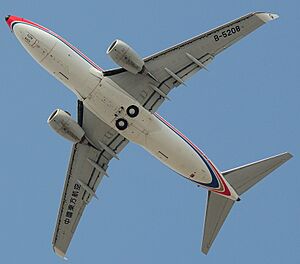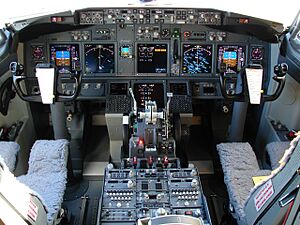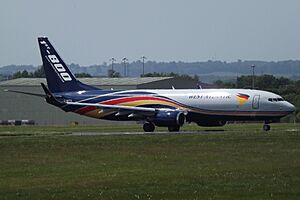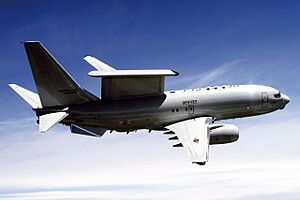Boeing 737 Next Generation facts for kids
Quick facts for kids Boeing 737 Next Generation737-600/-700/-800/-900 |
|
|---|---|
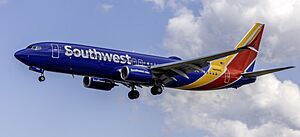
The 737-800 is the best-selling 737NG variant. Southwest Airlines (as seen in this April 2025 picture) is the largest operator.
|
|
| General information | |
| Type | Narrow-body jet airliner |
| National origin | United States |
| Manufacturer | Boeing Commercial Airplanes |
| Status | In service, military variants in production |
| Primary users | Southwest Airlines |
| Number built | 7,116 as of May 2025[update] |
| History | |
| Manufactured | 1996–2020 (civilian variants) 1996–present (military variants) |
| Introduction date | December 17, 1997 with Southwest Airlines |
| First flight | February 9, 1997 |
| Developed from | Boeing 737 Classic |
| Variants | Boeing Business Jet Boeing C-40 Clipper Boeing E-7 Wedgetail Boeing P-8 Poseidon |
| Developed into | Boeing 737 MAX |
The Boeing 737 Next Generation, often called 737NG, is a twin-engine airplane. It's a type of narrow-body aircraft made by Boeing Commercial Airplanes. This plane was first introduced in 1993 and has been built since 1997.
The 737NG is an improved version of the older 737 Classic series. It has a new wing design that is bigger and holds more fuel. This allows it to fly farther and carry more weight. The 737NG also uses modern CFM56-7 engines. It has a glass cockpit with digital displays and a redesigned inside for passengers. There are four main types: the –600, –700, –800, and –900. These planes can carry between 108 and 215 passengers. The main competitor for the 737NG is the Airbus A320 family.
As of May 2025, over 7,100 737NG planes have been delivered. The 737-800 is the most popular type. Boeing stopped making new passenger 737NGs in 2019. The last ones were delivered in January 2020. The 737NG has been replaced by the newer 737 MAX series.
Contents
How the 737NG Was Developed

Why Boeing Created the 737NG
Boeing decided to upgrade its 737 Classic planes when United Airlines bought the more advanced Airbus A320 family. The Airbus A320 had newer technology like fly-by-wire controls. In 1991, Boeing started working on a new series of aircraft. After talking with airlines, the 737 Next Generation (NG) program was announced on November 17, 1993.
Testing the New Planes
The first 737NG plane, a 737−700, was completed on December 8, 1996. This plane made its first flight on February 9, 1997. The first 737−800 prototype flew on July 31, 1997. The smallest new type, the −600 series, first flew on January 22, 1998. Boeing used 10 planes for testing: three -600s, four -700s, and three -800s.
Cool New Features
In 2004, Boeing offered a special package for short runways. This helps the planes take off and land better at smaller airports. This package is now standard on the 737-900ER.
In 2008, Boeing started offering new carbon brakes for the 737NG. These brakes are much lighter than the old steel ones. This weight saving helps the plane use less fuel. For example, a 737-800 can save about 700 pounds (318 kg) of weight.
New engine parts were tested in 2009. These improvements help the plane fly more smoothly and use about 2% less fuel on longer flights.
Better for Short Runways
This special design package is an option for the 737-600, -700, and -800. It is standard on the 737-900ER. These changes help the planes carry more weight or fuel when using runways shorter than 5,000 feet (1,524 meters).
The package includes:
- Special winglet tests that allow slower landing speeds.
- Improvements for takeoff, like sealed leading-edge slats. This helps the plane climb faster from shorter runways.
- Faster braking after landing to reduce stopping distances.
- Increased aerodynamic braking with flight spoilers.
- A special tail skid to prevent the tail from hitting the ground during landing.
The first plane with these features was delivered in July 2006. Many airlines have ordered this package.
Looking at the Structure
In 2019, cracks were found on a part of a 737NG called a "pickle fork." This part connects the fuselage (body) to the wing. It is designed to last a very long time. Boeing told the FAA about this issue. More planes were found to have similar cracks. Planes that had flown more than 30,000 times needed to be checked quickly.
By November 2019, about 5% of the first 1,200 planes checked had cracks. Boeing worked on fixing these planes. Checks were expanded to include more areas of the plane. About a quarter of the 6,300 737NGs around the world needed to be inspected.
After an engine problem on a Southwest Airlines Flight 1380 in April 2018, the National Transportation Safety Board (NTSB) suggested redesigning the engine cover (nacelle). This was recommended for about 6,800 planes.
How They Were Built
Boeing increased how many 737s it built each month. In 2010, they made about 31 planes a month. By 2018, they aimed to make 52 planes a month.
In 2016, a single 737 was built in just 10 days at the Boeing Renton Factory. This was much faster than before. The plane's body arrives on Day 1. Wires are put in on Day 2, and hydraulic systems on Day 3. On Day 4, the wings and landing gear are attached. On Day 6, the inside parts like airline seats, kitchens (galleys), and bathrooms are installed. Engines are added on Day 8. By Day 10, the plane is ready for test flights.
Boeing stopped putting together new passenger 737NGs in 2019. The last passenger plane was delivered in December 2019. The very last two were delivered in January 2020. However, military versions like the P-8 Poseidon are still being made.
What Came Next

For a while, Boeing thought about designing a completely new plane to replace the 737. This project was called "Boeing Y1." But in 2011, they decided to update the 737NG instead.
This update led to the Boeing 737 MAX. The MAX has more fuel-efficient engines and special winglets that split at the tip. The first 737 MAX flew in January 2016. The 737 MAX is the fourth generation of the 737, following the 737NG.
New "Split Scimitar winglets" became available for some 737NG models starting in 2014. These winglets look similar to the MAX's and help save even more fuel, up to 5.5%.
Design Features
The 737NG has a redesigned wing that is 25% larger. This bigger wing also holds 30% more fuel. It uses new, quieter, and more fuel-efficient CFM56-7B engines. The plane can also take off with more weight. Many 737NG models have winglets on the ends of their wings.
These improvements mean the 737NG can fly much farther, adding about 900 nautical miles (1,667 km) to its range. This allows it to fly over 3,000 nautical miles (5,556 km), making it possible for transcontinental flights.
Inside the Plane
The cockpit was updated with modern electronics. The passenger cabin also got improvements, similar to those found on the Boeing 777. This included more curved walls and larger overhead bins.
In 2010, Boeing offered a new "Sky Interior" for the 737NG. This design was inspired by the Boeing 787 Dreamliner. It features new overhead bins that pivot open, new side walls, and LED lighting that can change colors. Newer "Space Bins" can hold 50% more carry-on bags. Boeing also offered this as an upgrade for older 737NG planes.
Different Types of 737NG
737-600
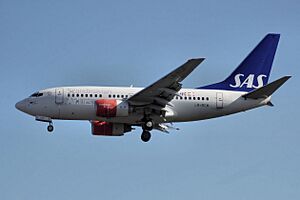
The 737-600 was first ordered by SAS in March 1995. The first plane was delivered in September 1998. Only 69 of these planes were made. The last one went to WestJet in 2006. The 737-600 replaced the older 737-500. It is similar in size to the Airbus A318. Winglets were not an option for this model.
737-700

In November 1993, Southwest Airlines started the Next-Generation program by ordering 63 737-700s. They received the first one in December 1997. This model replaced the 737-300. It usually carries 126 passengers in a two-class setup or up to 149 in an all-economy setup. It's similar to the Airbus A319.
As of July 2018, all 1,128 -700 series planes that were ordered have been delivered. About a thousand of these planes were in service by June 2018. Half of them were flown by Southwest Airlines.
The 737-700C is a special version that can be changed to carry cargo instead of passengers. It has a large door on the side. The United States Navy uses this version, calling it the C-40 Clipper.
737-700ER

Boeing launched the 737-700ER (Extended Range) in January 2006. All Nippon Airways was the first customer. This plane uses the body of the 737-700 but has the stronger wings and landing gear of the 737-800. With extra fuel tanks, it can fly much farther, up to 5,775 nautical miles (10,695 km). The first one was delivered in February 2007. It's similar to the Airbus A319LR.
737-800
The Boeing 737-800 is a longer version of the 737-700. It replaced the 737-400 and competes with the Airbus A320. The 737-800 can seat 162 passengers in a two-class setup or 189 in a single-class setup. It was launched in September 1994. The first one was delivered in April 1998 to Hapag-Lloyd Flug.
The 737-800 also helped fill the gap when Boeing stopped making the McDonnell Douglas MD-80 and MD-90 planes. Many airlines in the U.S. used the 737-800 to replace their older Boeing 727-200 planes.
The 737-800 uses less fuel than some older planes. For example, it uses about 80% of the fuel an MD-80 would use for a similar flight, while carrying more passengers.
As of May 2019, Boeing had delivered almost 5,000 737-800s. The 737-800 is the most popular type of 737NG. Ryanair, a large low-cost airline, has over 400 of these planes.
737-800BCF (Cargo)
In February 2016, Boeing started a program to turn passenger 737-800s into cargo planes. These are called 737-800BCF (Boeing Converted Freighter). The first converted plane was delivered in April 2018.
These planes are changed by adding a large cargo door and a system to handle cargo. They can fly up to 1,995 nautical miles (3,695 km) with a maximum takeoff weight of 174,100 pounds (79,016 kg).
737-800SF (Cargo)
In 2015, Boeing also started another passenger-to-freighter program with Aeronautical Engineers Inc (AEI). These are called 737-800SF. The first AEI converted plane was delivered to Ethiopian Airlines in March 2019. This version can carry 52,800 pounds (23,950 kg) of cargo and fly 2,000 nautical miles (3,704 km).
737-900

Boeing later introduced the 737-900, which is an even longer version. It is about 138 feet 2 inches (42.11 meters) long. Because it kept the same number of emergency exits as the 737-800, its seating was limited to 189 passengers. The 737-900 also had the same takeoff weight and fuel capacity as the -800. Alaska Airlines launched the 737-900 in November 1997. The first one flew in August 2000. Only 52 of these planes were delivered before the improved 737-900ER took its place.
737-900ER
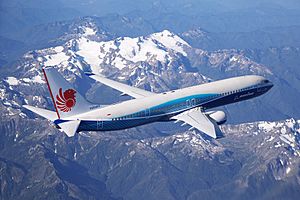
The 737-900ER (Extended Range) was the last and largest type of the Boeing 737 NG family. It was designed to fill the gap after the 757-200 was no longer made. It also aimed to compete directly with the Airbus A321.
This plane can have up to two extra fuel tanks and standard winglets. This helps it fly as far as other 737NG models. It also has an extra pair of exit doors and a flat rear wall, which allows it to carry up to 220 passengers. Airlines can choose to close off these extra doors if they carry 189 passengers or fewer.
The 737-900ER was launched in July 2005 and first flew in September 2006. The first plane was delivered to Lion Air in Indonesia on April 27, 2007. A total of 505 -900ERs were delivered.
Military Versions
- C-40 Clipper: This is a 737-700C used by the U.S. Navy for transport. The U.S. Air Force also uses C-40B and C-40C versions for transporting important leaders.
- E-7 Wedgetail: This plane is based on the 737-700ER. It's an airborne early warning and control (AEW&C) aircraft. This means it can detect other aircraft from far away. Australia was the first customer. Other countries like Turkey, South Korea, and the United Kingdom also use it.
- P-8 Poseidon: The P-8 is based on the 737-800ER. It has stronger wings from the -900 and special wingtips. The P-8 is a maritime patrol aircraft. It's used to watch over oceans. The U.S. Navy chose it to replace their older planes. Countries like Australia, Canada, and the United Kingdom also use the P-8.
Boeing Business Jet (BBJ)
The Boeing Business Jet (BBJ) is a special version of the 737NG designed for private and business travel. The first BBJ (called BBJ1) was like a 737-700 but had stronger wings and landing gear from the 737-800. It also had extra fuel tanks for a longer range. The first BBJ1 flew in September 1998. A total of 113 BBJ1s were delivered.
In 1999, Boeing launched the BBJ2. This plane is based on the 737-800. It is longer than the BBJ1, with 25% more cabin space and twice the baggage space. It also has extra fuel tanks and winglets. The first BBJ2 was delivered in February 2001.
The BBJ3 is based on the 737-900ER. It is about 16 feet (4.9 meters) longer than the BBJ2. Seven BBJ3s have been delivered.
Who Uses the 737NG
As of July 2018, over 6,300 Boeing 737 Next Generation planes were being used by airlines. This included 69 -600s, 1,027 -700s, 4,764 -800s, and 513 -900s.
Orders and Deliveries
Here's a table showing how many 737NG planes have been ordered and delivered over the years:
| Aircraft | Orders | Deliveries | |||||||||||
|---|---|---|---|---|---|---|---|---|---|---|---|---|---|
| Model series | Total | Unfilled | Total | 2025 | 2024 | 2023 | 2022 | 2021 | 2020 | 2019 | 2018 | 2017 | 2016 |
| 737-600 | 69 | — | 69 | — | — | — | — | — | — | — | — | — | — |
| 737-700 | 1,130 | 2 | 1,128 | — | — | — | — | — | — | — | 2 | 4 | 6 |
| 737-700C | 5 | — | 5 | — | — | — | — | — | — | — | — | — | 2 |
| 737-800 | 4,991 | 2 | 4,989 | — | — | — | — | — | — | 28 | 269 | 397 | 411 |
| 737-900 | 52 | — | 52 | — | — | — | — | — | — | — | — | — | — |
| 737-900ER | 505 | — | 505 | — | — | — | — | — | — | 22 | 34 | 37 | 52 |
| (Commercial Jets) | 6,752 | 4 | 6,748 | — | — | — | — | — | — | 50 | 305 | 438 | 471 |
| 737-700W | 14 | — | 14 | — | — | — | — | — | — | — | — | — | — |
| 737-800A | 191 | 6 | 185 | 3 | 5 | 9 | 12 | 16 | 14 | 17 | 18 | 17 | 18 |
| C-40A | 17 | — | 17 | — | — | — | — | — | — | 2 | — | 1 | — |
| C-40B/C | 9 | — | 9 | — | — | — | — | — | — | — | — | — | — |
| (Military jets) | 231 | 6 | 225 | 3 | 5 | 9 | 12 | 16 | 14 | 19 | 18 | 17 | 19 |
| BBJ | 113 | — | 113 | — | — | — | 1 | — | — | 1 | 1 | — | — |
| BBJ2 | 23 | — | 23 | — | — | — | — | 2 | — | — | — | — | — |
| BBJ3 | 7 | — | 7 | — | — | — | — | — | — | — | — | — | — |
| (Business jets) | 143 | — | 143 | — | — | — | 1 | 2 | — | 1 | 1 | — | — |
| (737 NextGen) | 7,126 | 10 | 7,116 | 3 | 5 | 9 | 13 | 18 | 14 | 70 | 324 | 455 | 490 |
| Aircraft | Deliveries | ||||||||||||||||||
|---|---|---|---|---|---|---|---|---|---|---|---|---|---|---|---|---|---|---|---|
| Model series | 2015 | 2014 | 2013 | 2012 | 2011 | 2010 | 2009 | 2008 | 2007 | 2006 | 2005 | 2004 | 2003 | 2002 | 2001 | 2000 | 1999 | 1998 | 1997 |
| 737-600 | — | — | — | — | — | — | — | — | 10 | 3 | 3 | 6 | 5 | 4 | 6 | 24 | 8 | — | — |
| 737-700 | 7 | 11 | 12 | 7 | 43 | 23 | 51 | 61 | 101 | 103 | 93 | 109 | 80 | 71 | 85 | 75 | 96 | 85 | 3 |
| 737-700C | — | — | — | — | — | — | — | 1 | — | — | — | — | — | — | 2 | — | — | — | — |
| 737-800 | 396 | 386 | 347 | 351 | 292 | 323 | 283 | 190 | 214 | 172 | 104 | 78 | 69 | 126 | 168 | 185 | 133 | 65 | — |
| 737-900 | — | — | — | — | — | — | — | — | — | — | 6 | 6 | 11 | 8 | 21 | — | — | — | — |
| 737-900ER | 73 | 70 | 67 | 44 | 24 | 15 | 28 | 30 | 9 | — | — | — | — | — | — | — | — | — | — |
| (Commercial Jets) | 476 | 467 | 426 | 402 | 359 | 361 | 362 | 282 | 334 | 278 | 206 | 199 | 165 | 209 | 282 | 284 | 237 | 150 | 3 |
| 737-700W | — | — | — | — | — | 2 | 2 | — | — | 5 | 2 | 1 | 1 | 1 | — | — | — | — | — |
| 737-800A | 15 | 13 | 8 | 9 | 5 | 1 | 3 | 2 | — | — | — | — | — | — | — | — | — | — | — |
| C-40A | — | 2 | — | — | 1 | 2 | — | — | — | 1 | — | 2 | — | 2 | 1 | 3 | — | — | — |
| C-40B/C | — | — | — | — | 1 | — | — | — | 1 | 2 | — | — | 2 | 1 | 1 | 1 | — | — | — |
| (Military jets) | 15 | 15 | 8 | 9 | 7 | 5 | 5 | 2 | 1 | 8 | 2 | 3 | 3 | 4 | 2 | 4 | — | — | — |
| BBJ | 3 | 1 | 5 | 2 | 6 | 4 | 4 | 4 | 5 | 7 | 3 | 3 | 1 | 7 | 12 | 10 | 25 | 8 | — |
| BBJ2 | — | 2 | 1 | 2 | — | 2 | — | 1 | — | 2 | 1 | — | 3 | 2 | 5 | — | — | — | — |
| BBJ3 | 1 | — | — | — | — | 4 | 1 | 1 | — | — | — | — | — | — | — | — | — | — | — |
| (Business jets) | 4 | 3 | 6 | 4 | 6 | 10 | 5 | 6 | 5 | 9 | 4 | 3 | 4 | 9 | 17 | 10 | 25 | 8 | — |
| (737 NextGen) | 495 | 485 | 440 | 415 | 372 | 376 | 372 | 290 | 330 | 302 | 212 | 202 | 173 | 223 | 299 | 280 | 278 | 166 | 3 |
Data as of May 2025[update]
Safety and Incidents
The Boeing 737 Next Generation series has been involved in some accidents. As of January 2020, there have been 22 serious accidents where the plane was destroyed. There were also 13 hijackings. Sadly, these events led to 767 deaths.
Boeing studied commercial airplane accidents from 1959 to 2017. Their study showed that the Next Generation series had a much lower accident rate than older 737 models. The deadliest event for a 737NG was Jeju Air Flight 2216. This 737-800 plane overshot the runway and crashed in South Korea on December 29, 2024. This accident resulted in 179 deaths out of 181 people on board.
Technical Details
Here are some technical details about the different 737NG models:
| Variant | 737-600 | 737-700 | 737-800 | 737-900ER |
|---|---|---|---|---|
| Cockpit crew | Two | |||
| 2-class | 108 (8F @36" 100Y @32") | 128 (8F @36" 120Y @32") | 160 (12F @36" 148Y @32") | 177 (12F @36" 165Y @32") |
| 1-class | 123 @32" - 130 @30" | 140 @32" - 148 @30" | 175 @32" - 184 @30" | 177 @32" - 215 @28" |
| Exit Limit | 149 | 189 | 220 | |
| Seat width | First: 22 in / 56 cm; Economy: 17 in / 43 cm | |||
| Length | 102 ft 6 in / 31.24 m | 110 ft 4 in / 33.63 m | 129 ft 6 in / 39.47 m | 138 ft 2 in / 42.11 m |
| Height | 41 ft 3 in / 12.57 m | 41 ft 2 in / 12.55 m | ||
| Wing | Span: 112 ft 7 in / 34.32 m, with winglets: 117 ft 5 in / 35.79 m; Area: 124.60 m2 (1,341.2 sq ft); Sweepback: 25°; AR: 9.44 | |||
| Fuselage | Width: 12 ft 4 in (3.76 m); Cabin width: 11 ft 7 in (3.53 m); Cabin height: 86.6 in (2.20 m) | |||
| OEW | 80,200 lb / 36,378 kg | 83,000 lb / 37,648 kg | 91,300 lb / 41,413 kg | 98,495 lb / 44,677 kg |
| MTOW | 144,500 lb / 65,544 kg | 154,500 lb / 70,080 kg | 174,200 lb / 79,016 kg | 187,700 lb / 85,139 kg |
| Fuel capacity | 6,875 US gal / 26,022 L | 7,837 US gal / 29,666 L | ||
| Lower deck cargo | 720 ft³ / 20.4 m3 | 966 ft³ / 27.4 m3 | 1,555 ft³ / 44.1 m3 | 1,826 ft³ / 51.7 m3 |
| Takeoff run | 1,878 m (6,161 ft) | 2,042 m (6,699 ft) | 2,316 m (7,598 ft) | 3,000 m (9,800 ft) |
| Flight envelope | 41,000 feet (12,497 m) Ceiling, Mach 0.82 (542 kn; 1,005 km/h) MMo | |||
| Cruise | Mach 0.785 (453 kn; 838 km/h) | Mach 0.781 (450 kn; 834 km/h) | Mach 0.789 (455 kn; 842 km/h) | Mach 0.79 (455 kn; 844 km/h) |
| Range | 3,235 nmi (5,991 km; 3,723 mi) | 3,010 nmi (5,570 km; 3,460 mi) | 2,935 nmi (5,436 km; 3,378 mi) | 2,950 nmi (5,460 km; 3,390 mi) |
| Engines (× 2) | CFM56-7B18/20/22 | CFM56-7B20/22/24/26/27 | CFM56-7B24/26/27 | |
| Thrust (× 2) | 20,000–22,000 lbf 89–98 kN |
20,000–26,000 lbf 89–116 kN |
24,000–27,000 lbf 110–120 kN |
24,000–27,000 lbf 110–120 kN |
| Cruise max. thrust | 5,960 lbf (26.5 kN) (climb) | |||
| Engine dimensions | Fan tip diameter: 61 in (155 cm), length: 103.50 in (263 cm) | |||
| Engine ground clearance | 18 in / 46 cm | 19 in / 48 cm | ||
| ICAO Type Designator | B736 | B737 | B738 | B739 |
See also
 In Spanish: Boeing 737 Next Generation para niños
In Spanish: Boeing 737 Next Generation para niños
- Competition between Airbus and Boeing
- Aircraft related to this one
- Boeing 737
- Boeing 737 Classic
- Boeing 737 MAX
- Boeing Business Jet
- Boeing C-40 Clipper
- Boeing E-7 Wedgetail
- Boeing P-8 Poseidon
- Boeing T-43
- Similar aircraft
- Airbus A320 family
- Boeing 717
- Boeing 757
- Airbus A220/Bombardier CSeries
- Comac C919
- Embraer 195
- McDonnell Douglas MD-90
- Lists related to this aircraft
- List of aircraft



